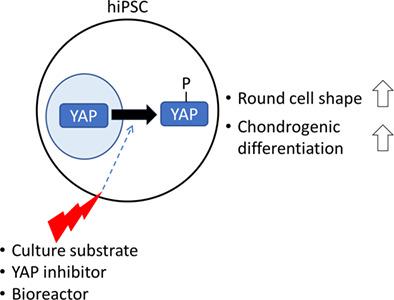当前位置:
X-MOL 学术
›
Stem Cells Transl. Med.
›
论文详情
Our official English website, www.x-mol.net, welcomes your
feedback! (Note: you will need to create a separate account there.)
Culture substrate-associated YAP inactivation underlies chondrogenic differentiation of human induced pluripotent stem cells.
STEM CELLS Translational Medicine ( IF 5.4 ) Pub Date : 2020-08-21 , DOI: 10.1002/sctm.20-0058 Akihiro Yamashita 1 , Hiroyuki Yoshitomi 2, 3 , Shunsuke Kihara 4 , Junya Toguchida 2, 3 , Noriyuki Tsumaki 1
STEM CELLS Translational Medicine ( IF 5.4 ) Pub Date : 2020-08-21 , DOI: 10.1002/sctm.20-0058 Akihiro Yamashita 1 , Hiroyuki Yoshitomi 2, 3 , Shunsuke Kihara 4 , Junya Toguchida 2, 3 , Noriyuki Tsumaki 1
Affiliation

|
Human induced pluripotent stem cells (hiPSCs) are a promising cell source for the creation of cartilage to treat articular cartilage damage. The molecular mechanisms that translate culture conditions to the chondrogenic differentiation of hiPSCs remain to be analyzed. To analyze the effects of culture substrates, we chondrogenically differentiated hiPSCs on Matrigel or laminin 511‐E8 while holding the composition of the chondrogenic medium constant. Cartilage was formed from hiPSCs on Matrigel, but not on laminin 511‐E8. On Matrigel, the hiPSCs were round and yes‐associated protein (YAP) was inactive. In contrast, on laminin 511‐E8, the hiPSCs were flat and YAP was active. Treating the laminin 511‐E8 hiPSCs in a bioreactor caused cell aggregates, in which the cells were round and YAP was inactive. Subsequent culture of the aggregates in chondrogenic medium resulted in cartilage formation. Transient knockdown of YAP in hiPSCs around the start of chondrogenic differentiation successfully formed cartilage on laminin 511‐E8, suggesting that the activation of YAP is responsible for the failure of cartilage formation from hiPSCs on laminin 511‐E8. Consistently, the addition of YAP inhibitors to laminin 511‐E8 hiPSCs caused partial cartilage formation. This study contributes to identifying the molecules that mediate the effects of culture substrates on the chondrogenic differentiation of hiPSCs as well as to developing clinically applicable chondrogenic differentiation methods.
中文翻译:

培养底物相关的 YAP 失活是人诱导多能干细胞成软骨分化的基础。
人类诱导多能干细胞 (hiPSC) 是一种很有前途的细胞来源,可用于制造软骨以治疗关节软骨损伤。将培养条件转化为 hiPSC 的软骨分化的分子机制仍有待分析。为了分析培养基质的影响,我们在基质胶或层粘连蛋白 511-E8 上进行软骨分化的 hiPSC,同时保持软骨培养基的成分不变。软骨是在 Matrigel 上由 hiPSC 形成的,但不是在层粘连蛋白 511-E8 上形成的。在 Matrigel 上,hiPSC 是圆形的,yes 相关蛋白 (YAP) 没有活性。相比之下,在层粘连蛋白 511-E8 上,hiPSC 平坦且 YAP 活跃。在生物反应器中处理层粘连蛋白 511-E8 hiPSC 会导致细胞聚集,其中细胞是圆形的,而 YAP 是无活性的。随后在软骨形成培养基中培养聚集体导致软骨形成。在软骨分化开始前后,hiPSCs 中 YAP 的瞬时敲低成功地在层粘连蛋白 511-E8 上形成软骨,这表明 YAP 的激活是导致 hiPSCs 在层粘连蛋白 511-E8 上未能形成软骨的原因。一致地,向层粘连蛋白 511-E8 hiPSCs 添加 YAP 抑制剂会导致部分软骨形成。本研究有助于确定介导培养基对 hiPSCs 成软骨分化的影响的分子,并有助于开发临床适用的成软骨分化方法。在软骨分化开始前后,hiPSCs 中 YAP 的瞬时敲低成功地在层粘连蛋白 511-E8 上形成软骨,这表明 YAP 的激活是导致 hiPSCs 在层粘连蛋白 511-E8 上未能形成软骨的原因。一致地,向层粘连蛋白 511-E8 hiPSCs 添加 YAP 抑制剂会导致部分软骨形成。本研究有助于确定介导培养基对 hiPSCs 成软骨分化的影响的分子,并有助于开发临床适用的成软骨分化方法。在软骨分化开始前后,hiPSCs 中 YAP 的瞬时敲低成功地在层粘连蛋白 511-E8 上形成软骨,这表明 YAP 的激活是导致 hiPSCs 在层粘连蛋白 511-E8 上未能形成软骨的原因。一致地,向层粘连蛋白 511-E8 hiPSCs 添加 YAP 抑制剂会导致部分软骨形成。本研究有助于确定介导培养基对 hiPSCs 成软骨分化的影响的分子,并有助于开发临床适用的成软骨分化方法。
更新日期:2020-08-21
中文翻译:

培养底物相关的 YAP 失活是人诱导多能干细胞成软骨分化的基础。
人类诱导多能干细胞 (hiPSC) 是一种很有前途的细胞来源,可用于制造软骨以治疗关节软骨损伤。将培养条件转化为 hiPSC 的软骨分化的分子机制仍有待分析。为了分析培养基质的影响,我们在基质胶或层粘连蛋白 511-E8 上进行软骨分化的 hiPSC,同时保持软骨培养基的成分不变。软骨是在 Matrigel 上由 hiPSC 形成的,但不是在层粘连蛋白 511-E8 上形成的。在 Matrigel 上,hiPSC 是圆形的,yes 相关蛋白 (YAP) 没有活性。相比之下,在层粘连蛋白 511-E8 上,hiPSC 平坦且 YAP 活跃。在生物反应器中处理层粘连蛋白 511-E8 hiPSC 会导致细胞聚集,其中细胞是圆形的,而 YAP 是无活性的。随后在软骨形成培养基中培养聚集体导致软骨形成。在软骨分化开始前后,hiPSCs 中 YAP 的瞬时敲低成功地在层粘连蛋白 511-E8 上形成软骨,这表明 YAP 的激活是导致 hiPSCs 在层粘连蛋白 511-E8 上未能形成软骨的原因。一致地,向层粘连蛋白 511-E8 hiPSCs 添加 YAP 抑制剂会导致部分软骨形成。本研究有助于确定介导培养基对 hiPSCs 成软骨分化的影响的分子,并有助于开发临床适用的成软骨分化方法。在软骨分化开始前后,hiPSCs 中 YAP 的瞬时敲低成功地在层粘连蛋白 511-E8 上形成软骨,这表明 YAP 的激活是导致 hiPSCs 在层粘连蛋白 511-E8 上未能形成软骨的原因。一致地,向层粘连蛋白 511-E8 hiPSCs 添加 YAP 抑制剂会导致部分软骨形成。本研究有助于确定介导培养基对 hiPSCs 成软骨分化的影响的分子,并有助于开发临床适用的成软骨分化方法。在软骨分化开始前后,hiPSCs 中 YAP 的瞬时敲低成功地在层粘连蛋白 511-E8 上形成软骨,这表明 YAP 的激活是导致 hiPSCs 在层粘连蛋白 511-E8 上未能形成软骨的原因。一致地,向层粘连蛋白 511-E8 hiPSCs 添加 YAP 抑制剂会导致部分软骨形成。本研究有助于确定介导培养基对 hiPSCs 成软骨分化的影响的分子,并有助于开发临床适用的成软骨分化方法。











































 京公网安备 11010802027423号
京公网安备 11010802027423号